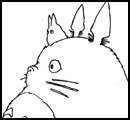It's easier to see Cameron's narrow obsessions in "Xenogenesis." To stretch his budget, he posits the short as a small chapter in a world-spanning space saga. Cheesy paintings describe other installments. Cameron would do the same with "The Terminator." The series may seem completely played out now, but it's been feeding off of the expansive back story of the first (independent and Hail Mary) film for twenty-five years. The short sequences of Kyle Reese in the Future War are exciting and colored beyond the edges of the film.
"Xenogenesis" has simple sci-fi beats for Cameron to drape his mastery of stop-motion and film-layering. The heroic Raj is out on a mission "to deliver humanity from the final cataclysm" when he encounters a giant cleaning droid. This droid has the same treads and proportions as the Hunter-Killers from the Terminator series. Just as he's about to get "swept away" by the droid, his partner appears in a spidery walking machine. She fights the droid in a scene that would later be refurbished as the climax of Cameron's masterpiece, "Aliens."
Even at this early stage, Cameron is a master at creating insane special effects using any budget or technique. Each shot in "Xenogenesis" works towards a functioning, other world. This is not an easy thing to do when a close-up on an actual set cuts to a wide shot of an immense room cuts to a stop-motion shot of two robots battling cuts to...
You can watch "Xenogenesis" online.
Steven Spielberg's twenty-five minute "Amblin'" doesn't point as succinctly to the director's future. He's been a little harder to pin down than Cameron. But he's still distinctly himself. "Spielbergian" is heard almost as much as "Lynchian." Maybe what "Amblin'" does illustrate is Spielberg's skill of shorthand characterization and his subtle experimentation.
"Amblin'" has a simple story of two hippie drifters, one good-looking guy and one good-looking girl. It's mostly silent, with a soundtrack suggesting an AM Gold version of Fairport Convention with less singing. In other words, it's kind of icky. The film becomes a clever interplay between emotive personalities, not unlike a modern Pixar short.
Perhaps atoning for the threadbare nature of his story, Spielberg uses some overt techniques to keep attentions from waning. In a long shot, the young man is seen slightly distorted as he runs towards the camera. It zooms out, revealing the reflection of a car's rear-view mirror. Not necessary, but kind of fun. Later (or is it before, I forget), the two drifters smoke weed in a large drainpipe. They're seen in a striking silhouette, evoking "E.T.'s" classic shot of bikers in the moon. (This shot has been combined with the word "Amblin" as Spielberg's production logo.)
"Amblin'" ends with a prescient idea. The girl looks in the guy's guitar case as he swims in the beach. Finding a nice shirt and tie, she realizes that he's appropriated the hippie lifestyle as a fashion choice. He's just another future automaton, working for the man. I leave you to decide to whom Spielberg relates more.


No comments:
Post a Comment